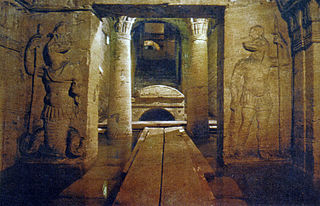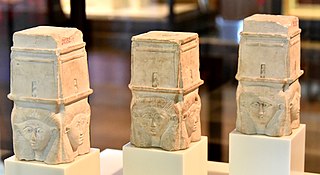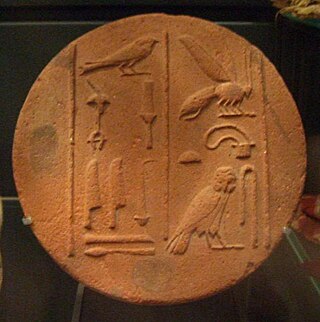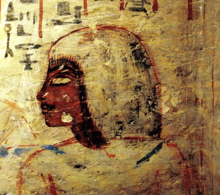
Egyptology is the study of ancient Egyptian history, language, literature, religion, architecture and art from the 5th millennium BC until the end of its native religious practices in the 4th century AD. A practitioner of the discipline is an "Egyptologist". In Europe, particularly on the Continent, Egyptology is primarily regarded as being a philological discipline, while in North America it is often regarded as a branch of archaeology.

Saqqara, also spelled Sakkara or Saccara in English, is an Egyptian village in the markaz (county) of Badrashin in the Giza Governorate, that contains ancient burial grounds of Egyptian royalty, serving as the necropolis for the ancient Egyptian capital, Memphis. Saqqara contains numerous pyramids, including the Pyramid of Djoser, sometimes referred to as the Step Tomb, and a number of mastaba tombs. Located some 30 km (19 mi) south of modern-day Cairo, Saqqara covers an area of around 7 by 1.5 km.

The Barbary lion, also called the North African lion, Berber lion, Atlas lion, and Egyptian lion, is an extinct population of the lion subspecies Panthera leo leo. It lived in the mountains and deserts of the Barbary Coast of North Africa from Morocco to Egypt. It was eradicated following the spread of firearms and bounties for shooting lions. A comprehensive review of hunting and sighting records revealed that small groups of lions may have survived in Algeria until the early 1960s, and in Morocco until the mid-1960s. Today, it is locally extinct in this region. Fossils of the Barbary lion dating to between 100,000 and 110,000 years were found in the cave of Bizmoune, near Essaouira.

The catacombs of Kom El Shoqafa is a historical archaeological site located in Alexandria, Egypt, and is considered one of the Seven Wonders of the Middle Ages.
Cats were represented in social and religious practices of ancient Egypt for more than 3,000 years. Several ancient Egyptian deities were depicted and sculptured with cat-like heads such as Mafdet, Bastet and Sekhmet, representing justice, fertility and power. The deity Mut was also depicted as a cat and in the company of a cat.

Neferefre Isi was an ancient Egyptian pharaoh of the Fifth Dynasty during the Old Kingdom period. He was most likely the eldest son of pharaoh Neferirkare Kakai and queen Khentkaus II. He was known as prince Ranefer before he ascended to the throne.

Tuna el-Gebel was the necropolis of Khmun. It is the largest known Greco-Roman necropolis in Egypt, dating from the New Kingdom to the Roman Period, and seeing heavy use in the Ptolemaic Period. Tuna el-Gebel is located in Al Minya Governorate in Middle Egypt.

The Royal Cache, technically known as TT320, is an Ancient Egyptian tomb located next to Deir el-Bahri, in the Theban Necropolis, opposite the modern city of Luxor.

Tomb KV19, located in a side branch of Egypt's Valley of the Kings, was intended as the burial place of Prince Ramesses Sethherkhepshef, better known as Pharaoh Ramesses VIII, but was later used for the burial of Prince Mentuherkhepshef instead, the son of Ramesses IX, who predeceased his father. Though incomplete and used "as is," the decoration is considered to be of the highest quality.

The Institut français d'archéologie orientale, also known as the French Institute for Oriental Archaeology in Cairo, is a French research institute based in Cairo, Egypt, dedicated to the study of the archaeology, history and languages of the various periods of Egypt's civilisation.

The pyramid of Neferefre, also known as the pyramid of Raneferef, is a 25th century BC unfinished pyramid complex built for the Egyptian pharaoh Neferefre of the Fifth Dynasty. Neferefre's unfinished pyramid is the third and final one built on the Abusir diagonal – a figurative line connecting the Abusir pyramids with Heliopolis – of the necropolis, sited south-west of Neferirkare's pyramid.

Animal mummification was common in ancient Egypt. Animals were an enormous part of Egyptian culture, not only in their role as food and pets, but also for religious reasons. Many different types of animals were mummified, typically for four main purposes: to allow beloved pets to go on to the afterlife, to provide food in the afterlife, to act as offerings to a particular god, and because some were seen as physical manifestations of specific deities that the Egyptians worshipped. Bastet, the cat goddess, is an example of one such deity. In 1888, an Egyptian farmer digging in the sand near Istabl Antar discovered a mass grave of felines, ancient cats that were mummified and buried in pits at great numbers.

Ptahemhat called Ty was High Priest of Ptah in Memphis during the time of 18th Dynasty reign of Tutankhamen and/or Ay.

Maia was the wet nurse of the ancient Egyptian pharaoh Tutankhamun in the 14th century BC. Her rock-cut tomb was discovered in the Saqqara necropolis in 1996.

In some European cultures it was customary to place the dried or desiccated body of a cat inside the walls of a newly built home to ward off evil spirits or as a good luck charm. It was believed that the cats had a sixth sense and that putting a cat in the wall was a blood sacrifice so the animal could use psychic abilities to find and ward off unwanted spirits. Although some accounts claim the cats were walled in alive, examination of recovered specimens indicates post-mortem concealment in most cases.
The Tomb of Thutmose is a small, decorated rock-cut tomb in Saqqara in Egypt that dates to the time shortly after the Amarna Period. The tomb is of special importance as one of the tomb owners was the sculptor Thutmose, often presumed to be the person who made the famous Nefertiti Bust. Another of the persons buried here was a certain Kenana.
The pyramid of Reherishefnakht is the tomb of the ancient Egyptian official Reherishefnakht. It is located in south Saqqara and was built right next to the pyramid of the 6th Dynasty pharaoh Pepi I. Reherishefnakht's pyramid however was probably built at the end of the 11th Dynasty or the beginning of the 12th Dynasty. It is the oldest Egyptian pyramid built for a person who was not a member of the royal family. The pyramid was discovered a few years before it was first excavated by Audran Labrousse and the Mission Archéologique Française de Saqqâra in 2005.
Wahtye was a high-ranking priest and official who served under King Neferirkare Kakai during the Fifth Dynasty of Egypt. Based on his skull, he was probably 35-years-old when he died.

Secrets of the Saqqara Tomb is a 2020 British documentary film directed by James Tovell. The film follows a team of Egyptian archeologists that discover a tomb from the 25th century BC in the Saqqara necropolis, just outside of Cairo that had been untouched for 4,400 years.
The archaeology of Ancient Egypt is the study of the archaeology of Egypt, stretching from prehistory through three millennia of documented history. Egyptian archeology is one of the branches of Egyptology.
















